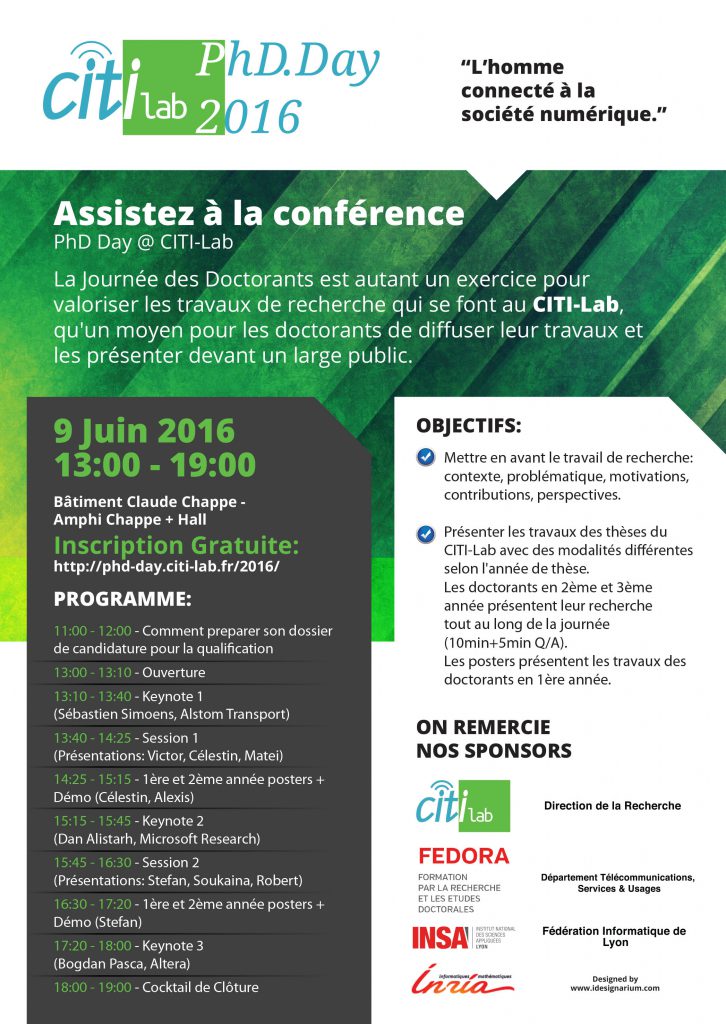Title
Distributed coding for dense IoT networks
Laboratory
CITI Lab. Centre of Innovation in Telecommunications and Integration of Service (www.citilab.fr)
Funding
This PhD will be supported by the chair Spie-ICS – INSA on IoT that will start in September 2016.
Contact
Prof. Jean-Marie Gorce
jean-marie.gorce@insa-lyon.fr
perso.citi.insa-lyon.fr/jmgorce
Topic
TWith the recent development of machine-to-machine (M2M) communications and internet-of-things (IoT) networks, the cellular network paradigm is evolving to serve massive IoT with bursty traffic in either uplink or downlink mode [3]. Although different techniques are already proposed on the market [2], the best strategy is not known. Considering this massive IoT network paradigm, classical medium access protocols are not efficient because they require lot of signaling for traffic scheduling and channel state information [4]. Multiplexing techniques such as FTDMA, CDMA or OFDMA would require complex synchronization and handshake mechanisms while random access techniques such as CSMA/CA introduce large overheads. In order to maximize the network life-time while ensuring low latency and high reliability, new distributed transmission techniques are necessary. The challenge is to approach the theoretical limits established for the asymptotic regime in [1]. An ideal technique in uplink mode would let the nodes to transmit randomly at their own convenience without any coordination mechanism but with perfect reliability. In downlink, the BS should be able to transmit simultaneously to several nodes while each node would be able to easily decode its own information without complex processing. To approach these limits, the main part of the computational complexity needs to be put at the base station side (in both downlink and uplink cases) using superposition coding or dirty paper coding in downlink mode and multi-user detection techniques in uplink. Additionally, simple but efficient modulation and coding schemes are necessary [4,5]. Another way may rely on exploiting recent results in distributed estimation theory that provided bounds on the reconstruction errors [6]. In addition, opportunistic cooperative mechanisms and compressive sensing techniques when the sources are correlated are possible candidates to optimize the transmission techniques. In this PhD, the candidate will contribute to the design of a new transmission technique devoted to very small packets (as small as few bits) and will study the fundamental tradeoffs: energy efficiency vs spectral efficiency and reliability vs latency. He will design new PHY/MAC strategies and will derive the theoretical proofs of the system performance. The work proposed in this PhD could be of a great importance for the deployment of future IoT networks.
Key skills
The candidate should have earned an MSc degree, or equivalent, in one of the following field: information theory, signal processing, electrical engineering, applied mathematics. He should have a strong background in probabilities and information theory as well as in signal processing for wireless communications. The candidate should be familiar with Matlab and C/C++ languages.
Key words
Modulation and coding, distributed networks, rateless coding, estimation theory, information theory.
How to apply
– Email a motivation letter
– Full CV with project and courses that could be related to the subject
– Complete academic records (from Bachelor to MSc)
– 2 or 3 references
– Applications will be reviewed when they arrive until one candidate is selected
References
[1] Gorce, JM, Poor H.V. & Kelif, JM, “Spatial Continuum Extensions of Asymmetric Gaussian Channels (Multiple Access and Broadcast)”, https://hal.inria.fr/hal-01265184.
[2] Goursaud, C., Gorce, J. M. (2015). Dedicated networks for IoT: PHY/MAC state of the art and challenges. EAI endorsed transactions on Internet of Things.
[3] Dhillon, H. S., Huang, H., Viswanathan, H., & Valenzuela, R. A. (2014). Fundamentals of throughput maximization with random arrivals for M2M communications. Communications, IEEE Transactions on, 62(11), 4094-4109.
[4] Shirvanimoghaddam, M., Li, Y., Dohler, M., Vucetic, B., & Feng, S. (2015). Probabilistic rateless multiple access for machine-to-machine communication. Wireless Communications, IEEE Transactions on, 14(12), 6815-6826.
[5] Shirvanimoghaddam, M., Dohler, M., & Johnson, S. J. (2016). Massive Multiple Access Based on Superposition Raptor Codes for M2M Communications. arXiv preprint arXiv:1602.05671.
[6] Unsal, A., & Knopp, R. (2015). Distributed Sensing and Transmission of Sporadic Random Samples Over a Multiple-Access Channel. Communications, IEEE Transactions on, 63(10), 3813-3828.



